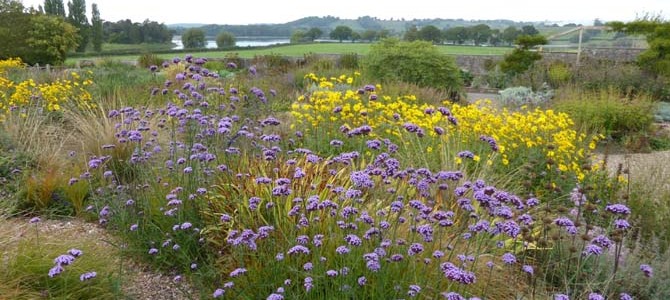Avondale Nursery:Plants for city gardens
by Drucilla James

Avondale Nursery specialises in unusual perennials and grasses together with ferns and bamboos, and features The Library Garden alongside its plant sales area. As you would expect with a library, the garden’s collection is meticulously labelled and catalogued, but beyond that, the colours of these living leaves are mixed and graduated with a painter’s eye - unsurprising when you find that, before they created this nursery, Brian Ellis and his wife Steph worked in art and printed textiles.
The purpose of the Library Garden is as a reference collection to make knowledge and understanding of plants accessible to all -from the least informed novice to most expert of gardeners. Visitors can see the plants in situ, with their characteristic growing habits and with possible planting companions and they are also issued with a clipboard to note down planned acquisitions that the Nursery will do its best to supply- if not immediately then in due course when the plants become available. You can even hand your sheet in and they will send it back as a reminder the next year.
Avondale Nursery was established ten years ago. Brian’s early career began in the 80s with a craft shop in Brixton –“a cooperative of fashion-designers and print makers”. He then graduated into landscaping and gardening; this grew into a full-time job, including selling at WIs and plant fairs and eventually led to the establishment of his first nursery and then Avondale.
For the first-time visitor, finding the nursery is a journey of discovery. It lies at the end of a winding track and, on the day we arrive, one of mixed sun and clouds, the garden is ablaze with colour. At a time when many garden borders are looking rather green or are supplemented by temporary bedding displays, the colours here are a revelation of the rich palette available for late summer and autumn. These include discoveries like the Sanguisorbas. With colours ranging from white to deep red , we particularly like the white ‘Ivory Towers’ , the pink ‘Pink Brushes’ and the red tenuifolia ‘Henc Gerritson’ which looks great with grasses.
Avondale Nursery is the National Collection holder for the Sanguisorba together with Anenome Nemerosa and Aster Novae-Angliae. Asked why these particular plants, Brian confesses that their choice was somewhat serendipitous, there is “no logic”, although having the three has the virtue of interest for each season – with Anenomes for spring, Sanguisorbas for summer and Michaelmas daisies for autumn. And of the impulse behind becoming a National Collection holder, Brian explains it as being “not a botanist, more a stamp collector - once I start collecting I want the set.”
The garden is roughly a square with criss-crossing paths and rather Bridge at Arles-looking raised dark beams as a central focal point; there is a shaded area down one side. Each of the paths offers a stunning vista with the flowers made more interesting for being seen through the veil of grasses planted throughout the borders. In a relatively small space, there seems like an endless variety of different-coloured pathways – from oranges, and yellows of Heleniums, Rudbeckias and Crocosmia and the newly discovered joys of blue and white Agapanthus to the pinks and reds of Sedums, Phlox and Anemone. The inspiration behind the garden is a painterly one,“ It is laid out for combinations of plants and it is designed with the plants. There is no hard landscaping”.
As you trace the paths through super-abundant head-height flowers and foliage, the list of covetable riches to be carried back home gets more and more extensive. Amongst the Rudbeckias and Helenium, for example, we loved Rudbeckia laciniata ‘Hortensia'; Rudbeckia fulgida var. deamii, Rudbeckia fulgida var. sullivantii ‘Goldsturm’, and Helenium ‘Fiesta’ ; favourite Agapanthus included ‘Northern Star’ and ‘White Heaven’. There were the Echinaceas too like purpurea Rubinstern. As well as individual varieties, there were also great combination plantings such as Veratrum nigrum, planted with Kniphofia and Pennisetum macrourum with Verbena bonariensis.
Asked to pick out some plants suitable for the small city garden, Brian says the key is always to buy foliage never flowers “because flowers are there for six weeks and foliage is there for nine months.” With this in mind he recommends, Gunneras, Heucheras and Actaeas for the shade and Sedums for sunnier areas particularly the coloured-leaf varieties “which will grow in any soil – you’ve got leaves and then you’ve got flowers.” He suggests the varieties ‘Karfunkelstein’, ‘Red Cauli’ and telephium ‘Xenox’.
Brian also recommends their own Michaelmas daisies which have “just been flowering themselves silly” particularly ’Glow in the Dark’ which he has bred himself with “black stems, dark leaves and glowing pink flowers -so that looks good when it’s not flowering.”
There are also ferns to try like the “lovely” Polystichum setiferum ‘Bevis’ which is evergreen and Adiantum aleuticum imbricatum – “a lovely little dainty fern for the shade.”
Asked about extending garden interest into winter, Brian suggests some grasses to try in small gardens including Stipa ichu, a smaller Miscanthus sinensis ‘Ghana’ with its “coppery red leaves and nice feathers which will stay; it will go brown by the end of the winter but will still stand and look good with frost on” , Miscanthus Nepalensis which has “beautiful tassels like the fez on a hat so they drape/ hang rather than stand up” and Miscanthus sinensis ‘Red Chief’.
There are plenty of new acquisitions to think about here. In the meantime, Brian will “soon be chopping everything back to the ground for the winter and propagating everything in sight!” ready for new collectors and visitors when the garden re-opens in March
Avondale Library Garden and Nursery
Mill Hill, Baginton, near Coventry CV8 3AG
Opening times: March to September

